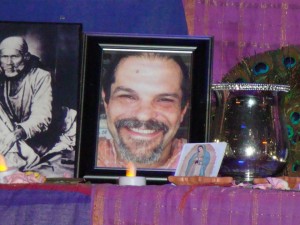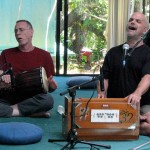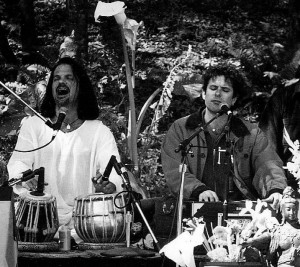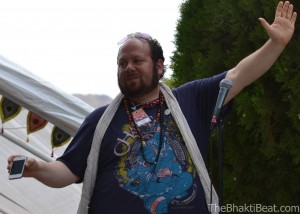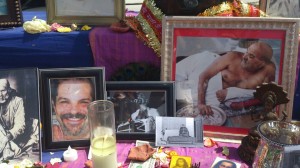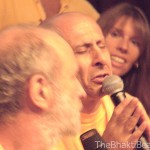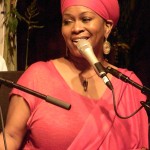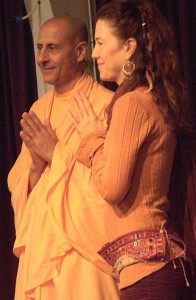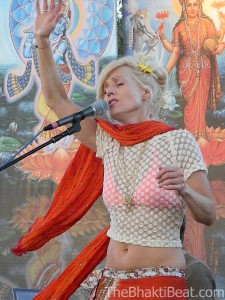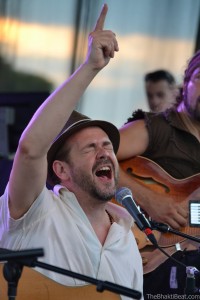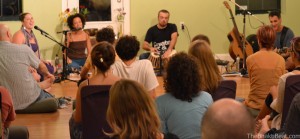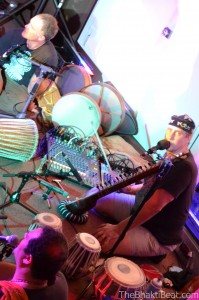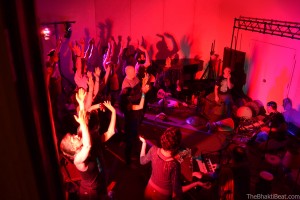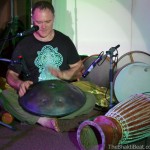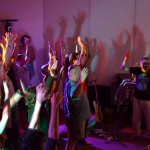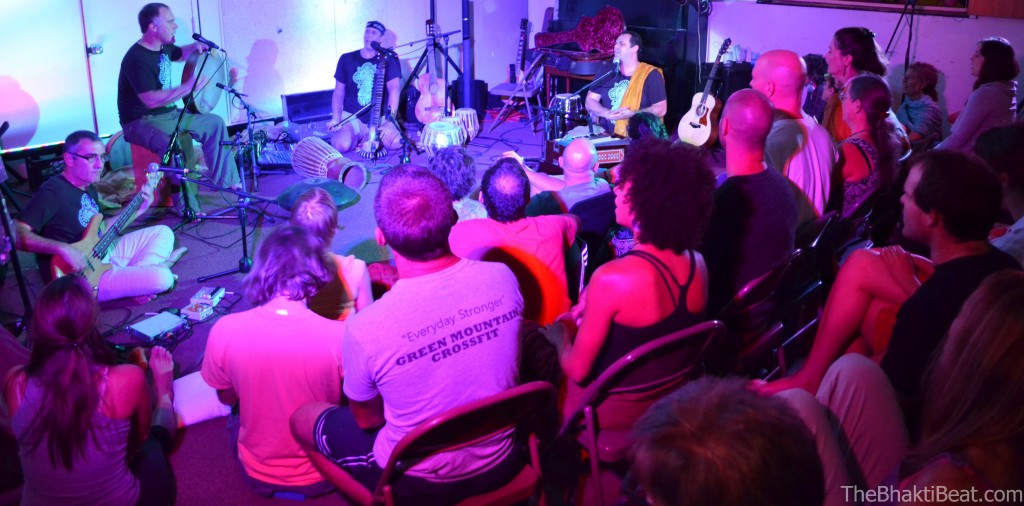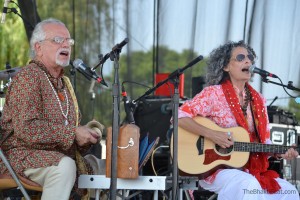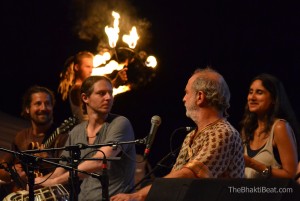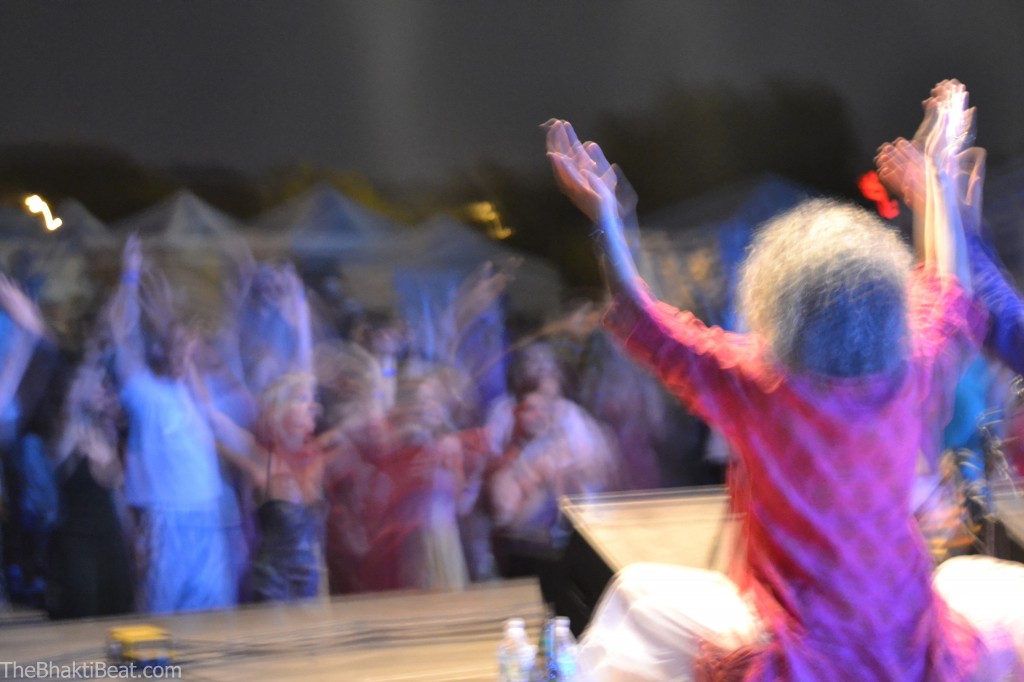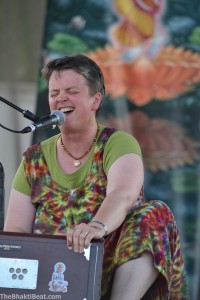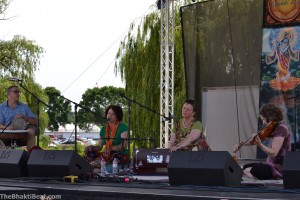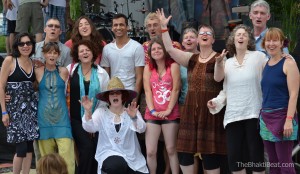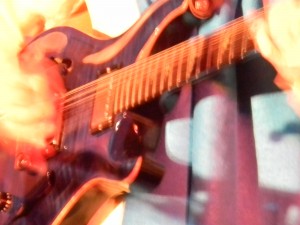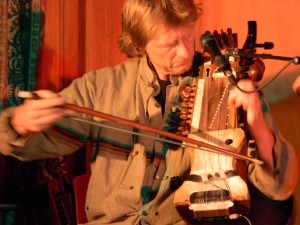For all the festiveness of Bhakti Fest, the nonstop bhav was tinged with an underlayer of shock and sadness as the news spread that one of bhakti’s own had died suddenly just two days prior to the gathering in the desert. Geoffrey Gordon, master percussionist, producer, composer, wallah and Neem Karoli Baba flame-keeper, was gone. Gordon was one of the original bhakti brothers from the Ram Dass era who helped sow the seeds of the Western kirtan movement, drumming alongside Krishna Das, Jai Uttal, Bhagavan Das, and many others.
It was fitting, perhaps, that so many heard the news first at Bhakti Fest, because, as Girish told the fest’s emcee, Shiva Baum: “There is only a Bhakti Fest today because of the work that Geoffrey started with Jai Uttal all those many years ago when it wasn’t widely popular yet to sing kirtan.”
We first heard the news from the Bhakti Fest Main Stage, early on Day 1. Ben Leinbach was about to launch into a song in his set with Prajna Vieirra, when he silenced his guitar abruptly, whispered “I just thought of something…”, then put his head down, hand at forehead, as if trying to collect himself. His voice deep with emotion, he told us of Gordon’s death and dedicated the set to his friend and collaborator. The morning crowd hushed and people exchanged perplexed glances, heads shaking in disbelief.
Leinbach’s was the first of many heart-rending tributes to a man who — while not exactly a household name in the broader world of kirtan — was deeply loved and respected by the brotherhood of bhaktas that forms the core of modern Western kirtan. The wallahs knew him, without exception, and their love for him poured forth. Sruti Ram fought back tears as he dedicated the Hanuman Chalisa to Gordon during SRI Kirtan’s set. Sean Johnson recounted how Gordon, in their last conversation, had told him how pleased he was to see the next generation of artists moving kirtan forward. Girish moved half the crowd to tears with a poignant tribute at the end of his set on Sunday. Krishna Das called him “a good friend for a long time” in his Sunday afternoon workship (Gordon played tabla on KD’s debut CD, One Track Heart, and they have collaborated many times since).
Jai Uttal: ‘A Great Buddy’
In his headline set Thursday night, Jai Uttal told the crowd that Gordon was “a very very dear friend of mine and of the bhakti community here in the United States.” He said he had first met Gordon in 1969 or ’70, when they “were both young yogi kids looking to get high.” (“And we did,” he added with a wink, to a ripple of chuckles.) But then, normally joyful Jai got uncharacteristically serious. And quiet….He quickly introduced the next song — an 18-minute joyride of a Hare Krishna chant interspersed with his now-signature “Help! I Need Somebody” Beatles-inspired chorus. Perfect.
In an email, Uttal said “Geoffrey and I played so much music together for so many years. He was a key member of the Pagan Love Orchestra and he also played tablas and sang with me for literally thousands of kirtans. He was deep into the devotional path and also a committed musician, always trying to learn and grow. He was also a great buddy.”
“I trust that by now Geoffrey is jamming in the heavenly Kirtan band, gazing into Maharajji’s shining face, and showering love and bliss upon his family and beloveds still here on Earth,” Uttal wrote in a facebook post Sept. 6, the day of his Bhakti Fest performance.
Shiva Baum: Gordon ‘A True Bhakta’
Shiva Baum, who as the former head of A&R/Triloka Records pioneered the mantra music movement in the West and views Gordon as a “beloved uncle…friend, mentor and co-conspirator,” told us in an email: “Geoffrey was loved by all who knew him. He was extraordinarily passionate and always on the side of the artist. He was an advocate for the “little guy” — the musicians behind the scenes who the spotlight often missed but whose contributions were essential. His heart was massive and he was able to pull you over to the right side of the road if you ever fell astray. He was someone who truly valued friendship and knew that the value of life was love. He was a true Bhakta.”
And, Baum added: “Perhaps most importantly, he sang one of the most beautiful versions of the Hanuman Chalisa I have to this day ever heard. You can only sing like that if you are truly a devotee. Geoffrey was and will always be.”
Influenced Early On by George & Ravi
Gordon’s love affair with the tabla apparently begain in 1971, when according to a biography on Gordon’s website, he went to see The Concert for Bangladesh at Madison Square Garden, the epic East-meets-West event organized by George Harrison and Ravi Shankar and featuring Bob Dylan, Eric Clapton and many others. Ravi Shankar and tabla maestros Ustad Ali Akbar Khan and Ustad Allarakha — Gordon’s future teachers — performed as the opening act.
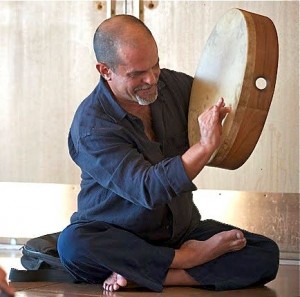 “This concert had a profound effect on Geoffrey,” his bio says. “He knew there and then that he wanted to study North Indian classical music and learn to play the tabla.”
“This concert had a profound effect on Geoffrey,” his bio says. “He knew there and then that he wanted to study North Indian classical music and learn to play the tabla.”
A year later, he met Ram Dass and became a devotee of Neem Karoli Baba. His bio details a long and rich history as a student-turned-teacher and professional percussionist for recordings in many musical genres as well as plays, films, and dance theatre. “He wasn’t ‘just a drummer,'” says long-time friend Mohan Baba. “He was a full-on, professional world percussionist.” To which Baba quickly adds: “Of course, his real love was his spiritual focus, and his drumming reflected that.”
Gordon’s passion for devotional music stayed with him to the end. He reportedly received a standing ovation for a percussion solo at a concert in Sedona the Sunday night before his death. He was on his way home to Santa Fe that Tuesday when he suffered a massive heart attack along the way, Mohan Baba told The Bhakti Beat. He said Gordon was evacuated by helicopter to the nearest hospital but resuscitation attempts en route failed to revive him.
‘Turn Off and Float Downstream’
My first kirtan with Gordon leading was at Bhakti Fest just last year. It was a morning set, and the low desert sun was already blasting its intensity onto the musicians on stage and the small crowd of early risers. I remember the set being quietly powerful somehow, in a way I can’t readily describe — it was as if it really didn’t matter to Gordon if anyone was there, because he was singing to something deeper…
When I searched my files for the photos I was sure I had taken that day, all I found was a single three-and-a-half-minute video:
The song, Tomorrow Never Knows, was written by John Lennon. Jai Uttal covered it, with Geoffrey Gordon on percussion, on the 2001 Grammy-nominated CD Mondo Rama by Uttal and the Pagan Love Orchestra, where it was fused with a Shiva chant. It seems to have been a favorite of Gordon’s in his fairly new incarnation as kirtan wallah; he sang it again at his last kirtan in Sedona the Sunday morning before he died, according to Sedona kirtaneer Natesh Ramsell, who met Gordon for the first time that weekend.
Here are the words, as Gordon sings them in the video:
Relax your mind, turn off and float down stream
It is not dying, it is not dying
Lay down all thoughts, surrender to the void,
It is shining, it is shining.
That you may know the meaning of within
It is being, it is being
Om Namah Shivayah, Shivayah Namaho…
Or play the game “Existence” to the end
Of the beginning, of the beginning, of the beginning, of the beginning.
Memorial Services Honor Gordon’s Life
A memorial service for Geoffrey Gordon was held Tuesday, Sept. 25 at Open Secret Bookstore in San Rafael, Calif., where Jai Uttal, Ben Leinbach, and dozens of other artists offered their musical tributes. And on Sunday, Sept. 30, friends will gather at the Neem Karoli Baba Ashram in Taos, N.M., to chant and celebrate his life. The Ashram’s page includes a link for contributions to assist in the funeral and memorial expenses and other financial needs of Gordon’s long-time wife, Sandra.

Also see: www.geoffreygordon.com
To contribute: http://www.nkbashram.org/community-geoffrey-fund
———————————————————————————————
Additional Coverage from The Bhakti Beat’s Big Bhavalicious Adventure to Omega Chant, Bhakti Fest West and Sat Nam Fest East: Bringing Home The Bhav: Bhakti-Fried Bliss-Chaser Faces ‘The Laundry’ of Life (Video) Wallah to Watch: Jai-Jagdeesh, Songstress & Classical Dance Artist, Dazzles at Sat Nam Fest (Videos) With Deva’s Miten, Krishna Das Does Dylan & Shyamdas Does the Blues (Videos) ‘It Is Not Dying:’ Geoffrey Gordon (1952-2012) Remembered in Bhakti Fest Tributes and Haunting Video Photo Journals from all 3 festivals on our facebook page. Check our YouTube channel for the latest video uploads. Stay tuned to this site for more coverage coming soon! Subscribe here.

